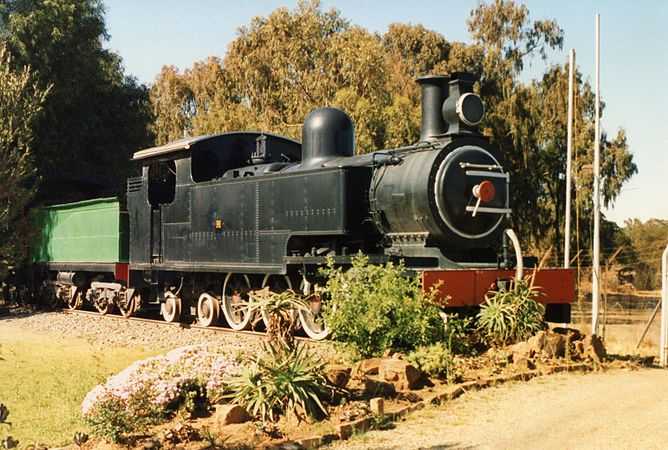South African Class J 4-6-4T
| South African Class J 4-6-4T | |
|---|---|
|
Class J no. 345, circa 1950 | |
| Type and origin | |
| Power type | Steam |
| Designer | South African Railways |
| Builder | Nasmyth, Wilson and Company |
| Serial number | 1060-1065 [1] |
| Model | Class J |
| Build date | 1915 |
| Total produced | 6 |
| Specifications | |
| Configuration | 4-6-4T "Baltic" |
| Gauge | 3 ft 6 in (1,067 mm) Cape gauge |
| Leading wheel diameter | 25.75 in (654 mm) |
| Driver diameter | 42.75 in (1,090 mm) |
| Trailing wheel diameter | 25.75 in (654 mm) |
| Wheelbase |
27 ft 5 in (8.357 m) total 5 ft 4 in (1.626 m) pilot 8 ft 6 in (2.591 m) coupled 5 ft 4 in (1.626 m) trailing |
| Length | 34 ft 0.75 in (10.382 m) |
| Height | 12 ft (3.658 m) |
| Axle load | 11.2 long tons (11.4 t) on 2nd driver |
| Weight on drivers | 32.7 long tons (33.2 t) |
| Locomotive weight |
90,832 lb (41.2 t) empty 52.4 long tons (53.2 t) w/o |
| Fuel type | Coal |
| Fuel capacity | 3 long tons (3.0 t) |
| Water capacity | 1,200 imp gal (5,500 l) |
| Boiler |
3 ft 10.75 in (1.187 m) inside diameter 10 ft 4 in (3.150 m) inside length 6 ft 9 in (2.057 m) pitch |
| Boiler pressure | 175 psi (1,210 kPa) |
| Firegrate area | 15 sq ft (1.394 m2) |
| Heating surface: – Tubes |
171 tubes 1.75 in (44.4 mm) diameter 821 sq ft (76.273 m2) |
| – Firebox | 88 sq ft (8.175 m2) |
| – Total | 909 sq ft (84.449 m2) |
| Cylinders | Two |
| Cylinder size |
15 in (381 mm) bore 22 in (559 mm) stroke |
| Valve gear | Walschaerts |
| Performance figures | |
| Tractive effort | 15,200 lbf (68 kN) at 75% pressure |
| Career | |
| Operator(s) | South African Railways |
| Class | Class J [1][2] |
| Number in class | 6 |
| Number(s) | 341-346 |
| Delivered | 1915 |
| First run | 1915 |
| Withdrawn | 1957 |
The South African Class J 4-6-4T of 1915 is a South African steam locomotive from the South African Railways era.
In 1915 the South African Railways placed six Class J tank steam locomotives with a 4-6-4 Baltic type wheel arrangement in service.[1][2]
Manufacturer
The Class J 4-6-4 Baltic type tank steam locomotive was designed by D.A. Hendrie, the Chief Mechanical Engineer (CME) of the South African Railways (SAR) from 1910 to 1922, to cope with the increasing traffic on the Natal South Coast. These locomotives had Walschaerts valve gear and Belpaire fireboxes and used saturated steam. Six of them were built by Nasmyth, Wilson and Company of Patricroft in Salford, England, and delivered in 1915, numbered in the range from 341 to 346.[1][3]
Service
As intended, the locomotives were placed in service working the Natal South Coast, but it was soon found that, due to their small proportions, they were unable to handle the rapidly increasing loads. They were therefore taken off the South Coast run and employed as shunters in the Durban harbour.[1]
Four of them were later allocated to Mossel Bay and the Cape Midland for similar duties, and remained there until they were withdrawn from service by 1957. The remaining two, numbers 341 and 342, were sold to gold mines on the Reef.[1][3][4]
By the early 1970s number 341 was still at work on the East Daggafontein Mine as their number 2. It was later acquired by the South African National Railway And Steam Museum (SANRASM) for preservation. It had to be scrapped in 2011, however, after being vandalised by scavenging scrap metal thieves at the SANRASM storage site in Chamdor.[4][5]
Illustrated
-

No. 341, East Daggafontein Mine no. 2, plinthed at SANRASM with a tender prior to being vandalised into destruction, 9 October 1989
See also
- List of South African locomotive classes
- South African locomotive history
- Tank locomotive numbering and classification
- The 4-6-4 "Baltic"
References
|
- ↑ 1.0 1.1 1.2 1.3 1.4 1.5 Holland, D.F. (1972). Steam Locomotives of the South African Railways, Volume 2: 1910-1955 (1st ed.). Newton Abbott, Devon: David & Charles. p. 32. ISBN 978-0-7153-5427-8.
- ↑ 2.0 2.1 South African Railways and Harbours Locomotive Diagram Book, 2’0” & 3’6” Gauge Steam Locomotives, 15 August 1941, as amended
- ↑ 3.0 3.1 Paxton, Leith; Bourne, David (1985). Locomotives of the South African Railways (1st ed.). Cape Town: Struik. p. 33. ISBN 0869772112.
- ↑ 4.0 4.1 Middleton, John N. (2002). Railways of Southern Africa Locomotive Guide - 2002 (as amended by Combined Amendment List 4, January 2009) (2nd, Dec 2002 ed.). Herts, England: Beyer-Garratt Publications. p. 16.
- ↑ SA Rail (Official Journal of the Railway Society of Southern Africa.
.jpg)